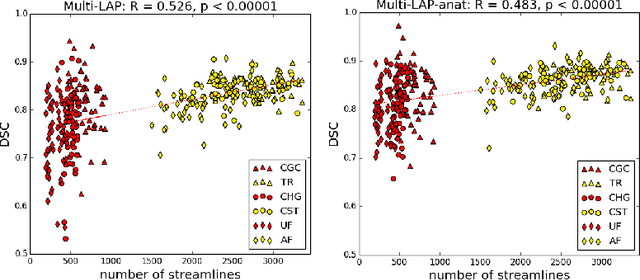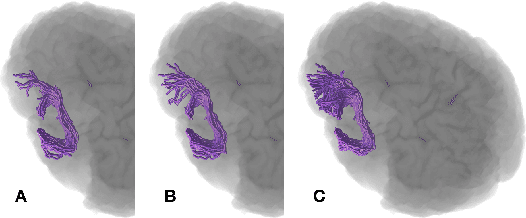Franco Pestilli
A labeled Clinical-MRI dataset of Nigerian brains
Nov 08, 2023Abstract:We describe a Magnetic Resonance Imaging (MRI) dataset from individuals from the African nation of Nigeria. The dataset contains pseudonymized structural MRI (T1w, T2w, FLAIR) data of clinical quality. The dataset contains data from 36 images from healthy control subjects, 32 images from individuals diagnosed with age-related dementia and 20 from individuals with Parkinson's disease. There is currently a paucity of data from the African continent. Given the potential for Africa to contribute to the global neuroscience community, this first MRI dataset represents both an opportunity and benchmark for future studies to share data from the African continent.
Anatomically-Informed Multiple Linear Assignment Problems for White Matter Bundle Segmentation
Jul 16, 2019


Abstract:Segmenting white matter bundles from human tractograms is a task of interest for several applications. Current methods for bundle segmentation consider either only prior knowledge about the relative anatomical position of a bundle, or only its geometrical properties. Our aim is to improve the results of segmentation by proposing a method that takes into account information about both the underlying anatomy and the geometry of bundles at the same time. To achieve this goal, we extend a state-of-the-art example-based method based on the Linear Assignment Problem (LAP) by including prior anatomical information within the optimization process. The proposed method shows a significant improvement with respect to the original method, in particular on small bundles.
Quantifying error in estimates of human brain fiber directions using Earth Mover's Distance
Dec 04, 2014



Abstract:Diffusion-weighted MR imaging (DWI) is the only method we currently have to measure connections between different parts of the human brain in vivo. To elucidate the structure of these connections, algorithms for tracking bundles of axonal fibers through the subcortical white matter rely on local estimates of the fiber orientation distribution function (fODF) in different parts of the brain. These functions describe the relative abundance of populations of axonal fibers crossing each other in each location. Multiple models exist for estimating fODFs. The quality of the resulting estimates can be quantified by means of a suitable measure of distance on the space of fODFs. However, there are multiple distance metrics that can be applied for this purpose, including smoothed $L_p$ distances and the Wasserstein metrics. Here, we give four reasons for the use of the Earth Mover's Distance (EMD) equipped with the arc-length, as a distance metric. (continued)
Deconvolution of High-Dimensional Mixtures via Boosting, with Application to Diffusion-Weighted MRI of Human Brain
Sep 26, 2014



Abstract:Diffusion-weighted magnetic resonance imaging (DWI) and fiber tractography are the only methods to measure the structure of the white matter in the living human brain. The diffusion signal has been modelled as the combined contribution from many individual fascicles of nerve fibers passing through each location in the white matter. Typically, this is done via basis pursuit, but estimation of the exact directions is limited due to discretization. The difficulties inherent in modeling DWI data are shared by many other problems involving fitting non-parametric mixture models. Ekanadaham et al. proposed an approach, continuous basis pursuit, to overcome discretization error in the 1-dimensional case (e.g., spike-sorting). Here, we propose a more general algorithm that fits mixture models of any dimensionality without discretization. Our algorithm uses the principles of L2-boost, together with refitting of the weights and pruning of the parameters. The addition of these steps to L2-boost both accelerates the algorithm and assures its accuracy. We refer to the resulting algorithm as elastic basis pursuit, or EBP, since it expands and contracts the active set of kernels as needed. We show that in contrast to existing approaches to fitting mixtures, our boosting framework (1) enables the selection of the optimal bias-variance tradeoff along the solution path, and (2) scales with high-dimensional problems. In simulations of DWI, we find that EBP yields better parameter estimates than a non-negative least squares (NNLS) approach, or the standard model used in DWI, the tensor model, which serves as the basis for diffusion tensor imaging (DTI). We demonstrate the utility of the method in DWI data acquired in parts of the brain containing crossings of multiple fascicles of nerve fibers.
 Add to Chrome
Add to Chrome Add to Firefox
Add to Firefox Add to Edge
Add to Edge